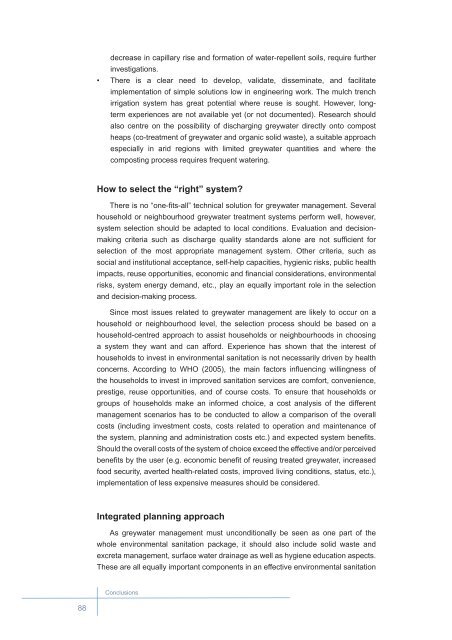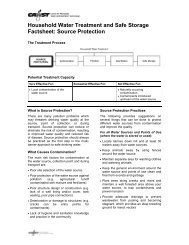Greywater Management in Low and Middle-Income Countries - SSWM
Greywater Management in Low and Middle-Income Countries - SSWM
Greywater Management in Low and Middle-Income Countries - SSWM
Create successful ePaper yourself
Turn your PDF publications into a flip-book with our unique Google optimized e-Paper software.
decrease <strong>in</strong> capillary rise <strong>and</strong> formation of water-repellent soils, require further<br />
<strong>in</strong>vestigations.<br />
• There is a clear need to develop, validate, dissem<strong>in</strong>ate, <strong>and</strong> facilitate<br />
implementation of simple solutions low <strong>in</strong> eng<strong>in</strong>eer<strong>in</strong>g work. The mulch trench<br />
irrigation system has great potential where reuse is sought. However, longterm<br />
experiences are not available yet (or not documented). Research should<br />
also centre on the possibility of discharg<strong>in</strong>g greywater directly onto compost<br />
heaps (co-treatment of greywater <strong>and</strong> organic solid waste), a suitable approach<br />
especially <strong>in</strong> arid regions with limited greywater quantities <strong>and</strong> where the<br />
compost<strong>in</strong>g process requires frequent water<strong>in</strong>g.<br />
<br />
<br />
household or neighbourhood greywater treatment systems perform well, however,<br />
system selection should be adapted to local conditions. Evaluation <strong>and</strong> decision-<br />
<br />
selection of the most appropriate management system. Other criteria, such as<br />
social <strong>and</strong> <strong>in</strong>stitutional acceptance, self-help capacities, hygienic risks, public health<br />
<br />
risks, system energy dem<strong>and</strong>, etc., play an equally important role <strong>in</strong> the selection<br />
<strong>and</strong> decision-mak<strong>in</strong>g process.<br />
S<strong>in</strong>ce most issues related to greywater management are likely to occur on a<br />
household or neighbourhood level, the selection process should be based on a<br />
household-centred approach to assist households or neighbourhoods <strong>in</strong> choos<strong>in</strong>g<br />
a system they want <strong>and</strong> can afford. Experience has shown that the <strong>in</strong>terest of<br />
households to <strong>in</strong>vest <strong>in</strong> environmental sanitation is not necessarily driven by health<br />
<br />
the households to <strong>in</strong>vest <strong>in</strong> improved sanitation services are comfort, convenience,<br />
prestige, reuse opportunities, <strong>and</strong> of course costs. To ensure that households or<br />
groups of households make an <strong>in</strong>formed choice, a cost analysis of the different<br />
management scenarios has to be conducted to allow a comparison of the overall<br />
costs (<strong>in</strong>clud<strong>in</strong>g <strong>in</strong>vestment costs, costs related to operation <strong>and</strong> ma<strong>in</strong>tenance of<br />
<br />
Should the overall costs of the system of choice exceed the effective <strong>and</strong>/or perceived<br />
<br />
food security, averted health-related costs, improved liv<strong>in</strong>g conditions, status, etc.),<br />
implementation of less expensive measures should be considered.<br />
<br />
As greywater management must unconditionally be seen as one part of the<br />
whole environmental sanitation package, it should also <strong>in</strong>clude solid waste <strong>and</strong><br />
excreta management, surface water dra<strong>in</strong>age as well as hygiene education aspects.<br />
These are all equally important components <strong>in</strong> an effective environmental sanitation<br />
Conclusions<br />
88
















